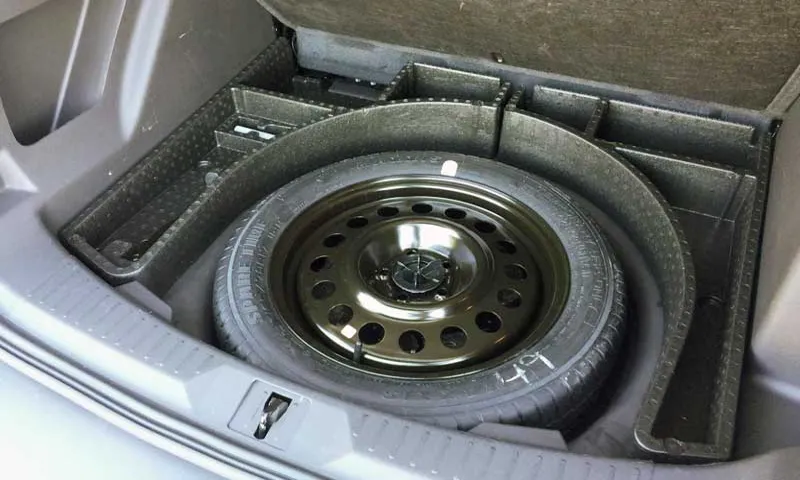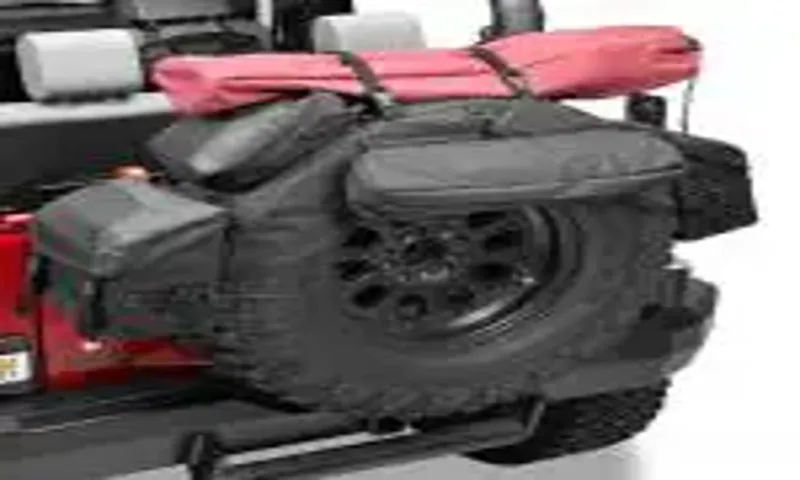If you’re driving and suddenly find yourself with a flat tire, the last thing you want to do is panic. It’s important to stay calm, pull over to the side of the road and assess the situation. But what if you’re not sure what to call the spare tire that’s tucked away in your trunk? Is it a donut? A space-saver? The truth is, there are different types of spare tires, each with their own unique names and functions.
In this blog, we’ll explore what a spare tire is called and the different types of spares you may encounter on the road.
Table of Contents
Introduction to Spare Tires
Have you ever wondered what that extra tire in the back of your car is called? It’s called a spare tire! It’s there for emergencies when you get a flat tire or a blowout while driving. In some countries, people refer to it as a “stepney,” but most commonly, it’s known as a spare tire. Spare tires are usually smaller than the regular tires and can be easily fitted on the wheel hub in case of an emergency.
They are specifically designed to get you to the nearest service center or tire shop to get a new tire or fix the existing one. It’s important to keep your spare tire properly inflated and in good condition, as you never know when you might need it. So, next time you see that round, black tire in the back of your car, you’ll know what it’s called and why it’s there!
Definition of Spare Tire
Spare tire Spare tires are emergency tires that a driver can use when one of the regular tires blows out or gets punctured. They are also known as a “donut” or “space-saver” tire and are usually smaller and lighter than regular tires. Spare tires are not designed for long-term use and should only be used to get the driver to a safe location where the flat tire can be repaired or replaced.
It is essential to ensure that the spare tire is properly inflated and securely attached to the vehicle before driving, as handling and braking may be affected. Despite the importance of spare tires, many modern cars are not equipped with them and instead come with tire repair kits that can temporarily seal a puncture. However, in cases of severe damage, a spare tire is the best option for ensuring the vehicle’s safety on the road.

Purpose of a Spare Tire
A spare tire is an important element to have in a car. Its primary use is to provide a temporary replacement for a punctured or damaged tire, allowing you to drive to a mechanic for a permanent fix. Without a spare, you may find yourself stranded on the side of the road, waiting for a costly tow truck.
Spare tires come in different sizes, so it’s important to have the correct size and type of spare tire to match your car’s existing tires. They also come in various forms, including full-size spares, compact spares, and temporary spares. A full-size spare offers the same performance as your regular tires, while a compact spare is lighter and takes up less space in your car.
However, a temporary spare is not meant for long-term use and should only be used to get you to a nearby repair shop. In summary, spare tires serve a crucial purpose in ensuring your road safety and avoiding unnecessary inconveniences. It’s recommended to check the tire pressure and condition of your spare tire periodically, to ensure it’s in good shape when you need it.
Always remember that a spare tire is only a temporary solution and should be replaced with a permanent tire as soon as possible. So, it’s important to have a spare tire in your car, knowing that it can come in handy in case of any emergencies.
Different Names for Spare Tires
Many people use different names to refer to spare tires. The most common name is “spare tire,” but some people also call it a “junk tire,” a “donut tire,” or a “space-saving tire.” The reason why spare tires have different names is that they come in different forms and sizes.
A full-size spare tire is basically an extra tire that is the same size as the other four tires on the car. On the other hand, a donut tire is a temporary spare that is much smaller and can only be used for a short period of time. Some people call it a “junk tire” because it is not meant to be used as a regular tire and is only meant to get you to the nearest repair shop.
Regardless of what it is called, a spare tire can be a lifesaver when you are stranded on the side of the road with a flat tire. So, make sure to familiarize yourself with where your spare tire is located in your vehicle and how to use it in case of an emergency.
Spare Tire
The spare tire is a necessary component in any vehicle, and it’s commonly known by many different names. Some people refer to it as a “donut,” while others call it a “space-saver.” Whatever you call it, the spare tire is there to help you out when you’re in a jam.
While they all serve the same purpose, each type of spare tire has its own unique features. For example, the “donut” spare tire is much smaller and lighter than a regular tire. This makes it easier to store in the trunk of your car, but it also means that it can only be driven for a short distance and at a slow speed.
The “space-saver” spare tire is also smaller than a regular tire, but it’s designed to be driven at higher speeds and for longer distances. No matter what type of spare tire you have, it’s important to make sure that it’s properly inflated and in good condition. After all, you never know when you might need it!
Donut
Donut If you’re in the market for a new car, you may have noticed that many modern cars don’t come with a full-size spare tire. Instead, they come with a smaller, temporary spare tire that is affectionately known by many names. The most common name is “donut,” due to their circular shape and small size.
But these tires are also called “space-savers,” “mini-spares,” or “emergency spares.” Despite their different names, these tires all serve the same purpose: to get you off the side of the road and to the nearest tire shop or dealership. Though they may not be as reliable as a full-size spare tire, donuts are a convenient backup option in case of a flat tire emergency.
So, if you find yourself with a donut spare tire, don’t fret – you’ll still be able to get where you need to go (just be sure not to exceed the recommended speed limit and driving distance!).
Space Saver
If you ever find yourself in need of a spare tire, you might be surprised to learn that these essential car accessories have several different names. For example, you might hear them referred to as a space saver, donut tire, or emergency tire. Whatever you call it, the purpose of these small, temporary tires is to help you make it to a mechanic safely and without damaging your car.
The design of spare tires has evolved over the years, with newer models often being smaller and lighter than traditional full-size spare tires. As a result, they take up less space in your trunk, which is why they’re sometimes called space savers. Regardless of what term you use, it’s important to ensure that your spare tire is properly inflated, in good condition, and suitable for your vehicle.
That way, you can rest easy knowing that you’re prepared for any unexpected roadside emergencies.
Types of Spare Tires
When it comes to car maintenance, a spare tire is definitely something you need to have at all times. But what is a spare tire actually called? It depends on the type of spare tire you have. There are several types of spare tires available in the market, each with its own unique name and purpose.
The most common type of spare tire is the full-size spare, which is the same size and type as the tires on your vehicle. Another type is the compact spare, which is smaller and less durable than a full-size spare, and is commonly known as a “donut” because of its shape. Run-flat tires are also another type of spare tire, which allows you to drive on them even after they get punctured for a certain distance.
Finally, there’s the collapsible spare, also called a “space-saver”, which is designed to save space in your vehicle. It’s important to know what type of spare tire you have so that you can use it appropriately during emergencies and when getting your vehicle serviced.
Full Size Spare Tire
When it comes to spare tires, there are several types to choose from. One of the most popular options is the full size spare tire. This type of spare tire is exactly what it sounds like – a spare tire that is the same size as the other tires on your vehicle.
This means that if one of your regular tires blows out, you can replace it with the full size spare and continue driving without any issues. One of the key benefits of a full size spare tire is that it provides a seamless transition from your regular tires to your spare. You don’t have to worry about any differences in handling or performance because the spare tire is the same size and type as your other tires.
This can be especially important if you’re driving on rough terrain or in inclement weather conditions. Another advantage of a full size spare tire is that it can actually save you money in the long run. If you have a small, compact spare tire, you may need to replace it more frequently than you would a full size spare.
This is because compact spares are not meant to be driven on for an extended period of time. So if you find yourself with a flat tire and have to use your spare, you may end up having to replace it much sooner than you would a full size spare. Overall, a full size spare tire is a smart investment for any vehicle owner.
It provides peace of mind and ensures that you can keep driving without any interruptions in the event of a flat tire. If you’re in the market for a spare tire, consider going with a full size option to get the most bang for your buck.
Compact Spare Tire
When it comes to spare tires, there are a few different types you can choose from. One common option is the compact spare tire. These are smaller than your standard tire, which means they take up less space in your trunk, but they’re also not designed to be a permanent solution.
Compact spare tires are meant to get you to a repair shop where you can get a full-size replacement. It’s important to note that these tires have a speed and distance limit, so you shouldn’t drive too far or too fast on them. While they may not be the ideal choice, they can be a lifesaver if you’re stranded on the side of the road with a flat tire.
Just make sure you get your full-size tire replaced as soon as possible.
Conclusion
In a world where flat tires and unexpected mishaps are all too familiar, the humble spare tire serves as a trusty sidekick, ready to take on the challenge and keep you rolling. While it may go by many names – from donut to space saver – its purpose remains the same: to save your bacon when you need it most. So next time you find yourself on the side of the road with a punctured tire, just remember – there’s a reason they call it a spare, because it’s always there when you need it!”
FAQs
Keyword: What is a spare tire called? 1. Q: What is the alternative word for spare tire? A: A spare tire can also be called a “donut” or “space saver” tire. 2. Q: Why do cars have a spare tire? A: Cars have a spare tire in case there is a flat tire during a journey. It is a backup option to continue driving until the vehicle reaches the repair shop. 3. Q: Can a spare tire be used for a long time? A: Spare tires are not designed for long-term use. They are meant to be temporary and used only for a short distance until the tire can be properly repaired or replaced. 4. Q: How long can a spare tire last unused? A: A spare tire can last up to 10 years if it has not been used. However, it is recommended to check the spare tire periodically for any signs of damage or wear. 5. Q: What is the difference between a spare tire and a regular tire? A: Spare tires are generally smaller and thinner than regular tires. They are designed to take up less space and weigh less so that they can be easily stored in the car’s trunk. 6. Q: Can a spare tire be different from the other tires on the car? A: Yes, a spare tire can be different from the other tires on the car. For example, a car may have a spare tire that is a different brand or size than the regular tires. 7. Q: Are all spare tires the same size? A: No, not all spare tires are the same size. The size of the spare tire will depend on the make and model of the car. It is important to check the car’s manual for the correct size of the spare tire.



